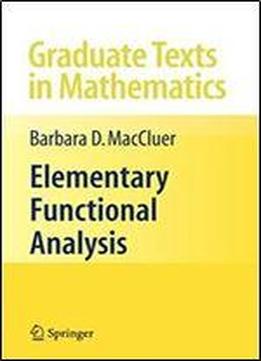
Elementary Functional Analysis (graduate Texts In Mathematics)
by Barbara MacCluer /
2008 / English / PDF
1.2 MB Download
Functional analysis arose in the early twentieth century and gradually, conquering one stronghold after another, became a nearly universal mathematical doctrine, not merely a new area of mathematics, but a new mathematical world view. Its appearance was the inevitable consequence of the evolution of all of nineteenth-century mathematics, in particular classical analysis and mathematical physics. Its original basis was formed by Cantor’s theory of sets and linear algebra. Its existence answered the question of how to state general principles of a broadly interpreted analysis in a way suitable for the most diverse situations. A.M. Vershik ([45], p. 438). This text evolved from the content of a one semester introductory course in fu- tional analysis that I have taught a number of times since 1996 at the University of Virginia. My students have included ?rst and second year graduate students prep- ing for thesis work in analysis, algebra, or topology, graduate students in various departments in the School of Engineering and Applied Science, and several und- graduate mathematics or physics majors. After a ?rst draft of the manuscript was completed, it was also used for an independent reading course for several und- graduates preparing for graduate schoolFunctional analysis arose in the early twentieth century and gradually, conquering one stronghold after another, became a nearly universal mathematical doctrine, not merely a new area of mathematics, but a new mathematical world view. Its appearance was the inevitable consequence of the evolution of all of nineteenth-century mathematics, in particular classical analysis and mathematical physics. Its original basis was formed by Cantors theory of sets and linear algebra. Its existence answered the question of how to state general principles of a broadly interpreted analysis in a way suitable for the most diverse situations. A.M. Vershik ([45], p. 438). This text evolved from the content of a one semester introductory course in fu- tional analysis that I have taught a number of times since 1996 at the University of Virginia. My students have included ?rst and second year graduate students prep- ing for thesis work in analysis, algebra, or topology, graduate students in various departments in the School of Engineering and Applied Science, and several und- graduate mathematics or physics majors. After a ?rst draft of the manuscript was completed, it was also used for an independent reading course for several und- graduates preparing for graduate school.











